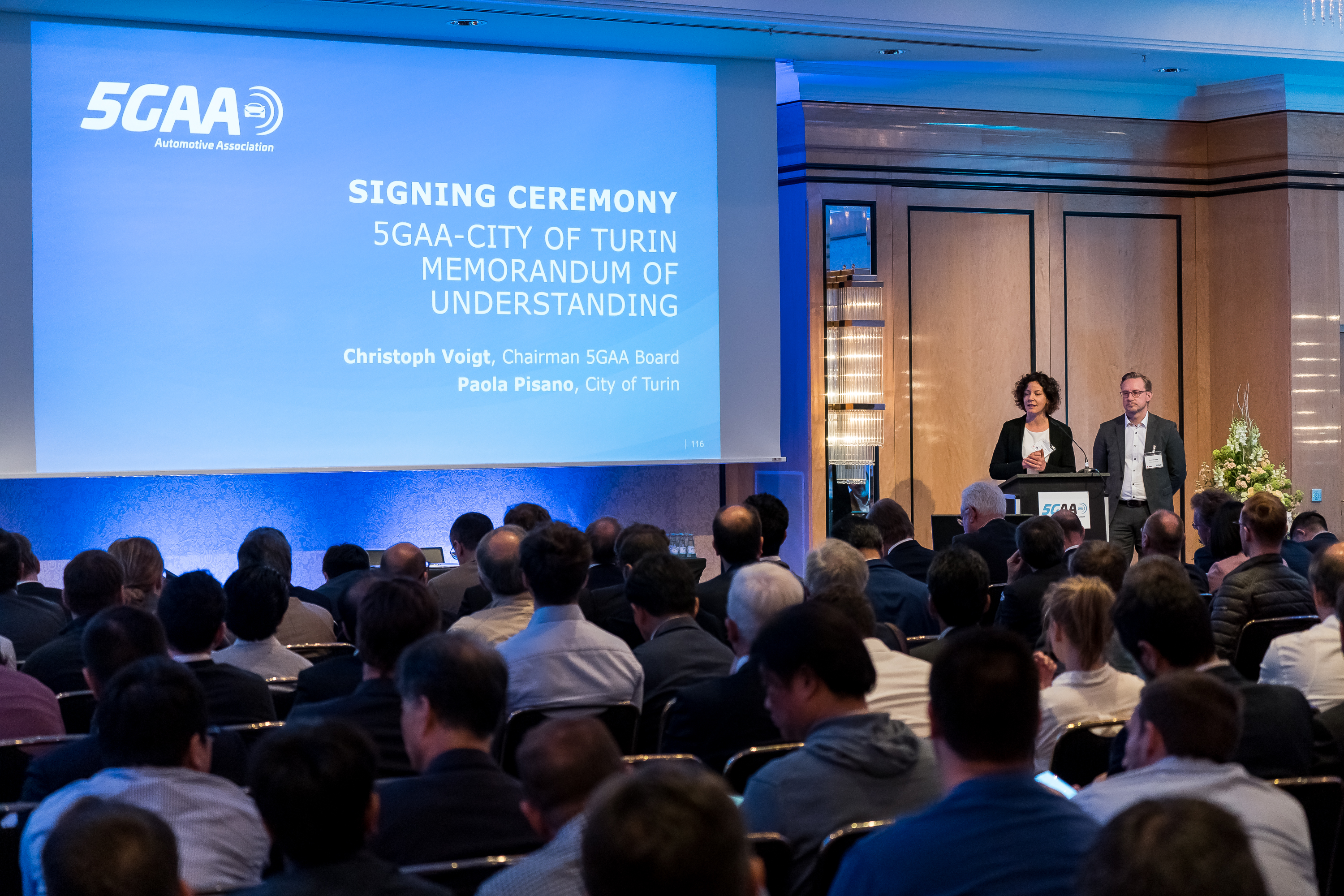
5GAA Meets Toronto 2019: Face-to-Face Meeting and Workshop
Toronto is hosting the next quarterly 5G Automotive Association (5GAA) Face-to-Face meeting. The event spans over five days focused on cellular-to-everything (C-V2X) technology.
The first three days will be dedicated to meetings on Working and Cross-Working Group Items. Days four and five will kick off with board and executive level discussions and a workshop on connected and automated driving in North America. These exciting events will be coupled with live demonstrations, hosted by 5GAA Canada-based members.
The 5GAA Workshop
5GAA will be hosting a workshop around ‘C-V2X: The Future of Connected and Automated Driving in North America’. With over 200 attendees expected, the event targets North American transport stakeholders, including policymakers, road traffic authorities, road operators and an array of interest groups and industry representatives. The primary objective is to raise awareness of C-V2X and the opportunity it provides to drive its adoption in North America.
The workshop will be divided in two parts, the first part will focus on an update to C-V2X development, including an overview of the European Road Map, as well as examples of recent innovation in Europe and North America. The second part will embark on a broader path, concentrating on future connected mobility. Key figures from Intelligent Transportation Systems (ITS) in North America will be presenting and take part in the day’s discussions. See workshop programme here.
Due to limited capacity, the workshop is by invitation only. Please contact liaison@5gaa.org for more information.
Live Demonstrations
5GAA members, Bell Canada and Huawei Canada, will organise two separate demonstrations of C-V2X 5G technology, 6-8 August 2019.
One demonstration, HD Mapping and Vulnerable Road User (VRU) Vehicle to Network, will take approximately 30 minutes and feature an in-vehicle live HD Map/VRU system.
The other demonstration will centre on Tele-operated Driving (ToD) Vehicle to Network technology. It will last approximately three hours at the Bell campus in Mississauga, Canada. There will be lunch served and a shuttle service to and from the Metro Toronto Convention Centre. Delegates can register here.

5GAA Supports the 3GPP 2nd 5G Vertical User Workshop
Following the first session held in Brussels on 12-13 February 2019, 5GAA returned to the second 5G Vertical User Workshop, which was in Rome on 9-10 July 2019. This initiative, launched by 3GPP Market Representative Partners (5GAA, 5G-IA, 5G-ACIA and PSCE) was organised as a collaborative event for strategic dialogue between vertical industries (technology, automotive and transport, health and public safety ) and 3GPP by exchanging on future needs and upcoming cellular standard developments.
5G networks are intended to bring a new innovative ecosystem, where actors from the vertical industries will be involved alongside the telecom operators, manufacturers, SMEs and research institutes. There is an increasing need to involve this wider range of industries to optimally capture end-user requirements and contribute to the 3GPP standardisation process. The working groups of 3GPP operate on a bottom-up basis focusing on partners contributions. As such, 3GPP notably benefits from further developing the role and usefulness of 5G vertical industries as Market Representation Partners.
The agenda for the 2nd 5G Vertical Users Workshop can be found here. The Workshop focused on 5G vertical technical viewpoints, common requirements and common interests with lively interactive discussions. 5GAA members Huawei, Nokia and Orange supported the workshop. The 5GAA CTO, Maxime Flament, had seized the opportunity to address:
- The 5GAA vision for 3GPP rel-17 as part of C-V2X and intelligent transport systems (available here)
- Predictive QoS, an innovative mechanism to provide in-advance QoS notifications from the network to the V2X application (available here)
5GAA enthusiastically supports the initiative and to enhance collaboration with partners such as 5G-IA, 5G-ACIA and PSCE.

5GAA Releases White Paper on C-V2X Use Cases: Methodology, Examples and Service Level Requirements
Several innovative automotive use cases using C-V2X technologies have emerged during the last years and many more will come in the following years in an attempt to describe novel capabilities and new features of connected vehicles. Safety, vehicle operations management, convenience, autonomous driving, platooning, traffic efficiency and environmental friendliness, society and community are some of the areas that C-V2X use cases are expected to have high impact.
This white paper describes 5GAA’s methodology in defining use cases and associated Service Level Requirements (SLRs) in a communications technology solution agnostic approach. Sequences of actions and interactions between involved actors are described as general as possible relative to the specific implementation and architecture of the overlaying cellular system. Moreover, an example set of C-V2X use cases have been described in detail and have been used to apply the 5GAA methodology. Each use case is composed of multiple use case scenarios, wherein use case scenarios can differ in terms of applicable road environment, actors involved, service flows, etc. The SLRs of the selected example use cases have been provided and analyzed in a technology and implementation agnostic way.
5GAA use cases are used by 5GAA work groups to develop C-V2X solutions, create test procedures, demos and pilots, evaluate spectrum needs and co-operate with Standards Development Organizations (SDOs) and finally create the business case and path for deployment.
Please note that this document is currently under revision
Click here to read the White Paper.

5GAA welcomes Council objection against C-ITS Delegated Act
The 5G Automotive Association (5GAA) welcomes the Council of the European Union’s objection against the proposal for Delegated Regulation on Cooperative Intelligent Transport Systems (C-ITS), as a clear signal of support to technology neutrality.
Brussels, Belgium – On 8th July 2019 the Council of the European Union adopted a decision to object against the proposal for Delegated Regulation on Cooperative Intelligent Transport Systems (C-ITS).
5GAA endorses the Council conclusions and will continue to advocate for an EU framework that abides by the principle of technology neutrality, inclusive of all available technical solutions, to improve road safety and traffic efficiency.
The current C-V2X generation, LTE-V2X, is fully standardised and ready for deployment in all world regions as emphasised by announcements from multiple OEMs in the USA and China.
5GAA and its members stand ready to engage in a positive dialogue with the European institutions and all stakeholders to define such a future-proof regulatory framework for cooperative, connected and automated mobility in Europe.

5GAA brings together key actors to share advances on C-V2X deployment in China at MWC Shanghai 2019
SHANGHAI, CHINA, 27 June 2019 – The 5G Automotive Association, with the engagement of relevant ecosystem actors in China, from Government officials to telecom and automaker companies and the larger 5GAA community, took stage today at the MWC Shanghai 2019 to explain the state of deployment of the ‘Cellular Vehicle-to-Everything’ (C-V2X) technology in this region.
“5GAA is instrumental in supporting the implementation of C-V2X technology in different parts of the world including China. The momentum in China reflects the fact that C-V2X is the verified, mature and preferred future proof technology for connected vehicles”, said Luke Ibbetson, 5GAA board member and Vodafone Group’s Head of Research and Development.
C-V2X as part of Chinese C-ITS standards
Representatives from different Chinese public institutions underlined during the conference that after issuing the three-year Industry Development Plans on Intelligent Connected Cars (ICV) and releasing C-V2X 5.9GHz ITS spectrum last year, ministries now accelerate standards system of ICV in order to solve the issue of interoperability in various scenarios. Meanwhile, the definition of smart highway standard has started in terms of infrastructure digitalization, Road-Transport unity, “Internet Plus” comprehensive services and new generation transport control network which will be enabled by C-V2X infrastructure and devices for both long range and short-range communication.
C-V2X Eco-system
There was strong engagement from industry stakeholders in China as well. It has been shared that 15 chipset/modules vendors are committed to support C-V2X for the Chinese market, 35 manufacturers are able to provide C-V2X infrastructure hardware or software, and in particular 15 car OEMs have recently announced the roll-out of C-V2X from 2020 H2 to 2021 H1. In order to improve C-V2X industry maturity, IMT2020’s C-V2X Working Group last year organized a “Three-Cross” interoperability tests for three Chipset vendors and 12 OEMs. Furthermore, an interoperability test called “Four-Cross” will be hosted to address more stakeholders and security by testing and verifying certification and authority system.
C-V2X Trial and Pre-commercial pilot
Many voices from the business side also explained the details for C-V2X deployment on the roads and vehicles in China, to be followed in other regions. There are more than 20 trials and pilot projects taking place where 100KM roads across 10 provinces will be digitalized with C-V2X.
Wuxi has been designated as national ICV pilot certificated by MIIT. C-V2X deployment in Wuxi will be extended from 240 intersections to 400 this year, focusing mainly on use cases of autonomous driving assistance and green waves for buses. It is estimated that 1-2 bus lanes will be completed with green wave deployment by end of this year, so as to improve punctuality, reduce emergent stop and waiting time of red light for buses.
Yanchong Highway will be deployed with C-V2X to embrace the 2022 Winter Olympic Games.
Other regions in China start deploying C-V2X by 2020, for instance, 40KM in Beijing Shunyi district and the international exhibition centre, 42KM in Shanghai Yangshan port, 4.5KM in Xiongan New Area, and the 30KM highway around Hainan province.
On top of showing the strong consolidation of C-V2X in China, the 5GAA event successfully underlined the progress of C-V2X application and services in terms of readiness of the ecosystem and commercialisation. However, China is not alone: 5GAA underlined its dedication to standardization, the eco-system and commercialisation of C-V2X in America, Europe, Japan and South Korea. Once again, 5GAA’s presence at MWC Shanghai successfully outlined the association’s vision in being a global player, and facilitating thought leadership platforms for relevant stakeholders driving towards building a better mobility ecosystem.
About 5GAA
The 5G Automotive Association (5GAA) is a global, cross-industry organisation of 115 members comprised of leading global automakers, Tier-1 suppliers, mobile operators, semiconductor companies, test equipment vendors, etc. working together to develop end-to-end solutions for future mobility and transportation services.
5GAA is committed to helping define and develop the next generation of connected mobility for autonomous based on Cellular-V2X (C-V2X), the family of cellular technology-based communications.
Contact
Marketing and Communications Team
Email: marcom@5gaa.org
Web: www.5gaa.org

5GAA and the City of Turin become official partners
The 5G Automotive Association officially became a partner of the City of Turin through the signature of a Memorandum of Understanding, at the occasion of 5GAA’s Connected and Automated Driving Workshop in Berlin on 23 May 2019.
The City of Turin is the first public authority 5GAA is officially partnering with. The Piedmontese capital, home to the Italian automotive industry, will work together with 5GAA to strengthen the collaboration between industry and the public sector and to facilitate the dialogue to drive innovation in mobility and transport. “The signature of a memorandum of understanding with a public authority, the City of Turin, is a first step towards the development of strategy public partnerships. We look forward to a fruitful collaboration” said 5GAA Chairman Christoph Voigt.
The City of Turin has started a linked strategic path to innovation (Torino City Lab, Smart Road) based on the opening of the city to frontier innovation, testing and experimentation on the whole urban territory using real environments and integrating new solutions within the city’s technological infrastructures, attraction and realization of new services. According to Innovation Counsellor Paola Pisano, “the intention is to place Turin into the innovation maps of 5GAA partners, providing the project with the know-how of the territory and the support of the Torino City Lab policy for the development of innovation in the areas of mobility and telecommunications, with a focus on 5G.”
5GAA’s objectives are fully aligned as the association intends to develop new partnerships with public authorities around C-V2X technical and testing activities to accelerate and support time-to-market and foreseen deployments in Europe and other world regions.
The City of Torino will be hosting the next 5GAA meeting in Europe in November 2019.


5GAA publishes test results in support to C-V2X FCC petition for waiver
Recently, the 5G Automotive Association (5GAA) filed a petition for waiver with the Federal Communications Commission of the United States requesting that C-V2X be allowed to operate in the upper 20 MHz (5905 MHz – 5925 MHz) of the US ITS band.
In support of this petition, 5GAA member companies have performed a series of tests in an attempt to address anticipated technical questions related to the favourable implementation of this petition. The report describes the test procedures and results that were undertaken to support the 5GAA C-V2X FCC petition for waiver in the 5.9 GHz band.
The report presents results of testing C-V2X in 20-MHz wide CH183 – the channel that has been recently proposed for C-V2X deployment in the ITS band and is referred to as basic C-V2X Channel and it allows for V2V and V2X messages such as basic safety message (BSM), signal phase and timing (SPaT), signal request message (SRM), signal status message (SSM), and others covered by the Road Safety Message under development in SAE standards. The upper part of the ITS band was chosen to minimize impact to DSRC channels, especially CH172.
The viability of C-V2X in 10 MHz has been demonstrated in a preceding report in which C-V2X has been shown to outperform DSRC in terms of reliability, resilience to out-of-band interference and range. This report extends these results by showing that a BSM message sent in 20‑MHz CH183 has the same reliability as previously shown in 10-MHz CH184.
Both lab and field data included in the report demonstrate consistent results:
- C-V2X communication in 20-MHz CH183 has the same reliability performance (Packet Reception Ratio vs. distance) as the identical BSM-like message transmission in 10-MHz CH184.
- Impact of C-V2X high load transmissions in CH183 on DSRC basic safety transmissions in CH172 is negligible up to a 1.4-km range in LOS conditions
- Impact of C-V2X high load transmissions in CH183 on V2I and I2V transmissions in CH178 is negligible up to a 1.4‑km range in LOS conditions
- Impact of C-V2X high load transmissions in CH183 on V2I and I2V transmissions in CH180 is negligible up to 1 km in LOS Conditions
Read the full report here.

5GAA “Connected and Automated Driving’’ Berlin Workshop

C-V2X contributes to safer roads for everyone: 5GAA live demo event in Berlin
Photos of the workshop can be found here. Click here to see the photos of the live demonstration.
Berlin, 23 May 2019 – Smart mobility technology, which we have been developing over the years, is now a reality. ‘Cellular Vehicle-to-Everything’ (C-V2X) allows vehicles to both communicate with the cloud and also directly with each other and their surroundings. Thanks to 4G LTE cellular technology, as well as the emerging 5G generation of high speed and low latency communications, traffic will be optimized, and emissions will be reduced. Emergency services will navigate smoothly and road safety for everyone, including vulnerable road users, will dramatically enhance.
At a live demo event in Berlin, the 5G Automotive Association (5GAA) presented a deep-dive into a smarter and safer mobility, giving a sneak peek of the technologies ready to be deployed. Prominent 5GAA members including BMW Group, Daimler, Deutsche Telekom, Fraunhofer Institutes FOKUS and ESK, Ford, Huawei, Jaguar Land Rover, Nokia, Qualcomm and Vodafone, demonstrated C-V2X Vehicle-to-Vehicle (V2V), Vehicle-to-Infrastructure (V2I) and Vehicle-to-Network (V2N) applications.
“Connected mobility standards are no longer a vision for the future,” says Maxime Flament, Chief Technology Officer at 5GAA. “The solutions on show are ready to be deployed today and have huge industry momentum based on the forthcoming 5G capabilities. C-V2X technology is a key foundation for a safe and sound driving environment for pedestrians, bicyclists, motorcyclists, cars and commercial heavy trucks. Global field testing is already in its very final stages and the first solutions are now commercially available from multiple suppliers.”
Using both direct short-range communications and mobile networks offers complementary capabilities as showcased in the demos, which involve tele-operated driving and the provision of emergency traffic information between vehicles using multi-access edge computing (MEC) functionality. All the demos use technology that is ready to be deployed.
A short summary on the 5GAA C-V2X use cases, showcased today at Berlin:
1. A. Traffic Management Solutions: Signal Phase and Timing (SPaT) and Red-Light Violation Warning (RLVW) to Vehicle
Waiting at the red light is not only time consuming, but idling, braking and accelerating release more pollutants. The communication between the traffic signal and vehicle is important to improve traffic flow, thus increasing road safety by preventing accidents. During the demo drive, a BMW Group vehicle equipped with a Qualcomm onboard unit running the Savari ITS software stack and the V2X use cases, communicates with a SWARCO traffic signal, showing C-V2X readiness across multiple vendors.
The use case enables the driver to monitor the upcoming traffic light. The center display of the vehicle shows the current signal phase and how long it will remain. In the Red Light Violation Warning (RLVW) use case, the application in the vehicle uses its speed and acceleration profile, along with the signal timing and geometry information from the traffic signal. If the driver is likely to run a red light he/she receives a warning in the vehicle.
B. Traffic Management Solutions: Emergency Electronic Brake light (EEBL)/ Roadworks warning (RWW)
C-V2X provides the driver with information so that he or she can adapt to the upcoming traffic situation in advance. Fraunhofer FOKUS, supported by Daimler, demonstrate an Emergency Electronic Brake Light Warning: Two vehicles equipped with Huawei onboard units are accelerating, and the car ahead brakes hard. The second car instantly receives a warning, demonstrating the advantage of the low-latency C-V2X communication. Furthermore, a Huawei roadside unit communicates ongoing roadwork via C-V2X to the vehicle. Visitors experience both use cases in the car viewing the warnings on the central display.
2. Real Time Emergency Alerts: Vehicle-to-Network and Network-to-Vehicle services
Vodafone Germany and Ford show connected vehicle technology (V2X) that could alert drivers to an accident ahead, moments after it has happened (via eCall Plus). Furthermore, the system provides early warning that emergency vehicles are approaching – and which side of the road other vehicles should move towards to avoid being an obstruction. Experts believe that survival rates for road accident victims can be improved by as much as 40% if they receive treatment just four minutes more quickly.
3. Live data capture and transmission: Expanded network/Vehicle-to-Network capacities via MEC
An ultra-fast, reliable and precise dissemination of safety-relevant information can save lives. Continental, Deutsche Telekom, Fraunhofer ESK and Nokia demonstrate how information is delivered to vehicles almost real-time via a mobile network, utilizing Multi-Access Edge Computing (MEC) technology. All data is processed at the edge of the mobile network to reduce transmission time (latency). As a result, event-related data such as emergency warnings as well as high-definition map data are transmitted in milliseconds, improving driving safety on the path to fully automated driving.
4. Combined Network and Direct solution enables the pinnacle of C-V2X technology
Vodafone Group, Huawei and Jaguar Land Rover demonstrate safety critical use cases by combining different communication modes (short direct via PC5 and longer-range network-based via Uu). The provision of a two-stage warning enables vehicles to be made aware of other vehicles approaching the same junction much earlier and allowing action to taken sooner to avoid a crash. Also, the number of road accidents because of unsafe lane changes and blind spots are significant. Using C-V2X technology helps automotive OEMs keeping the cost of implementing such warnings down by not having to install additional ‘one-off’ radio access systems for such warnings. The demos showcased the value and readiness of C-V2X and its ability to seamlessly combine both long range and short-range direct and longer-range network communication links. Specifically, it was shown that at a T-junction – a key site for accidents – connected cars benefit from longer range cellular network communication to deliver safety-related information beyond what alone can be delivered from short-range technology.
5. Remote-operated driving
Remote-Operated Driving (ROD) smooths the path to automated vehicles, anticipating situations in which remote human operator can intervene with the driving of the vehicle. ROD is enabled by low latency communication equipment e.g. by Huawei to deliver instructions or inputs to the vehicle to help it navigate challenging scenarios. Fraunhofer Institute FOKUS, supported by Daimler, showcase the reliability ROD enables already today.
_______________
Contact
Marketing and Communications Team
Email: marcom@5gaa.org

5GAA will discuss connected mobility through C-V2X at Mobile World Congress Shanghai 2019
MWC Shanghai 2019 is where tech industry innovators and influences will gather to explore how intelligent connectivity will shape the future of our digital experiences, our industry, and our world.
This time again, the 5G Automotive Association (5GAA) will lead the field of connected mobility by participating in GSMA’s major Chinese congress. On Thursday 27 June 2019, 5GAA will host a morning session with leading automotive and telecommunications companies worldwide, highlighting the readiness of the automotive and telecoms industries as to the deployment of the Cellular-Vehicle-To-Everything (C-V2X) technology.
Following its participation at MWC Shanghai 2018, 5GAA is proud to continue the facilitation of such thought leadership platforms for relevant stakeholders, driving towards building a better mobility ecosystem.
Join us on Thursday 27 June 2019 from 09:00 to 13:00 at the Kerry Hotel Pudong (Ballroom 5-7 on Level 3).
More information on the event page here.
Any question? Please contact marcom@5gaa.org.


